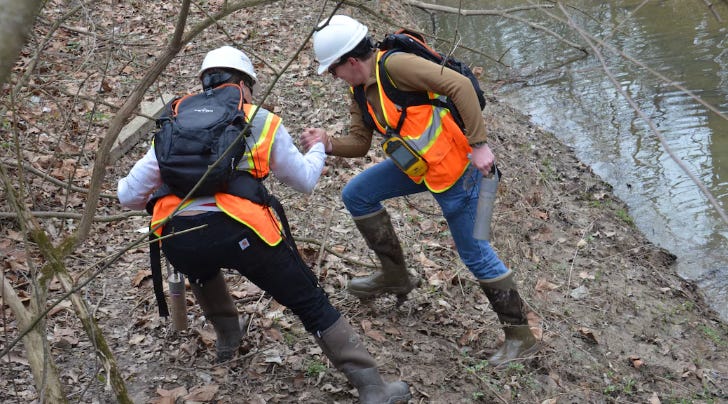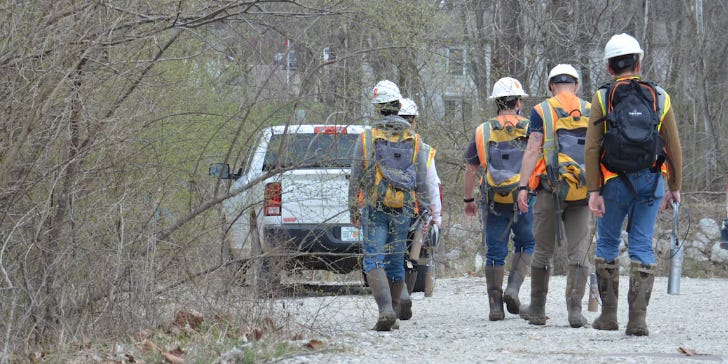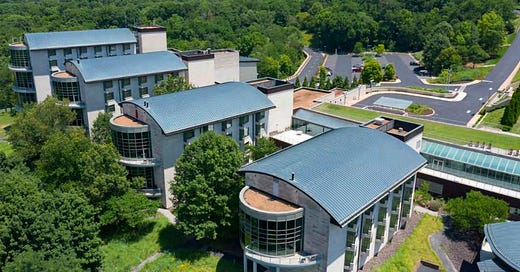
Augustine Institute: Nearby nuclear pollution ‘not a risk’
A contaminated creek has gotten Congressional attention. Will it impact a Catholic apostolate's planned move?
While activists and lawmakers call for more testing near a creek polluted with nuclear waste, a Catholic graduate school says the proposed Missouri location of its future campus is not in danger of contamination.
“We’ve done the due diligence, I’m not going to take a risk with my family, or myself, or my staff,” Augustine Institute president Tim Gray told The Pillar Wednesday, regarding the prospect of contamination from nuclear waste close to the Missouri campus where the lay-led graduate school intends to move this summer.
“I wouldn’t want to put any of our people at risk, and I certainly wouldn’t ‘bet the farm’ on something risky,” Gray added, explaining his confidence in a prospective Augustine Institute move to a 284-acre campus in Florissant, Missouri, which the institute is expected to buy for some $19 million at the end of April.
—
The Augustine Institute responded to questions as houses in Florissant, Missouri are undergoing testing by the Army Corps of Engineers, after nuclear contamination was found in their yards earlier this year.

The homes sit along Coldwater Creek, a waterway contaminated by uranium waste, which is two miles from the Boeing Leadership Center, the campus expected to be purchased by the Augustine Institute.
The Army Corps of Engineers began in late February drilling through basement floors to test soil samples below residences near the creek, after nuclear waste was found in the yards of houses in the Cades Cove subdivision, which sits along the waterway.
The creek itself began to be contaminated in the 1940s, when improperly stored nuclear waste warehoused near St. Louis’ airport made its way into the 19-mile-long stream, which flows into the Missouri River.
Beginning in the 1960s, soil from the creek, which was quietly known by some government officials to be contaminated, was used as fill dirt in local residential and commercial construction projects.
The extent of the contaminant’s spread — both from construction use, and from wind and erosion dissipation — is not clear. There are no records to indicate where the fill dirt was actually used, or how far from the creek banks it was taken by construction companies.
In 1989, the creek was designated a federal Superfund site, and remediation efforts have been underway since that time, which involve digging up tons of contaminated dirt near the creek and shipping it to designated waste facilities.
In 2022, an elementary school close to the creek, roughly two miles from the Boeing campus, was closed indefinitely, after nuclear contamination was found in the woods near the school, and in school classrooms and play fields. A federal nuclear remediation program has removed more than 600 truckloads of radioactive dirt from the school area, local media reported earlier this year, and overall cleanup efforts in the region are expected to be completed by 2038.

As the contamination makes national headlines and gets attention on Capitol Hill, some Catholics have asked whether the nearby nuclear pollution will deter the Augustine Institute’s planned move to a campus just two miles from the epicenter waterway, or whether the issue has motivated Boeing to offload the property.
Gray told The Pillar that the issue has been carefully scrutinized, and that he believes the property his institute plans to purchase is not affected by the radioactive contamination in the region.
“I really don’t think there is any basis of fact to any connection with the Boeing campus to this,” he said.
He explained that when his institute began exploring the purchase of the nearby property last year, Boeing officials were upfront about the situation, and their analysis of the potential risk.
“When Boeing built [the campus] in the 90s, they already knew about the Coldwater Creek issue, and they did a phase one and phase two environmental study, and they gave us those records,” Gray told The Pillar.
“And then they did another study just two years ago with soil samples,” Gray said, “and we’ve reviewed all of that as well. And we hired an environmental engineering company to work for us during our due diligence, and they confirmed that there is no contamination on the site.”
The Pillar received from the Augustine Institute a brief summary written by Riverfront Environmental, a consulting firm which said it had reviewed a 2022 set of Boeing-commissioned environmental site assessments, and performed a “general walk-over of the property” in February.
The summary did not specifically address whether the site could be at risk for eventual nuclear contamination, but said that 2022 soil samples found no significant problems, that there was no “obvious evidence of conditions of concern” and that “the environmental condition presented in the reviewed documents appears to support the intended future use as a graduate school, student dorms, conference center, and related support activities.”
The Pillar requested additional documentation specifically addressing the prospective risks of future surface or groundwater nuclear contamination, but has not received it as of press time.
But Dr. Ann Shortelle, a water scientist and a longtime river water management district official in Florida, told The Pillar that contamination is unlikely, and that the assessments conducted looked sound.
“The Superfund process always prioritizes public health,” Shortelle explained, in response to questions from The Pillar.
“The proposed area for the relocation of the Augustine Institute is not within the zone of known nuclear contamination, as demonstrated by extensive monitoring of the Superfund area. According to these data and modeling for future conditions, shallow groundwater from the Superfund site does not reach the proposed Augustine Institute,” she added.
“Extensive analyses of potential contamination of deep aquifers is considered highly unlikely for many centuries, if ever, due to local geology,” Shortelle added.
For his part, Gray said he’s also been assured that the campus will not be impacted by nearby nuclear pollution.
“There’s no risk for people being on the campus,” he told The Pillar.
“We’re at the highest elevation in the county,” he added, “and even in the water table, the water goes in the opposite direction of the property — [ground]water is flowing from Coldwater Creek to the Mississippi, but we’re uphill from that.”
Activists in the region, led by a group called Just Moms STL, have pushed for more testing in the area, arguing that the nuclear pollution has caused elevated incidences of illness for people in proximity to the creek and other contaminated sites, or who are unknowingly close to radioactive construction fill dirt taken from the creek’s banks.
The activists have gotten support from Republican Senator Josh Hawley and Democratic Representative Cori Bush, who have called for more widespread testing and federal cleanup dollars, along with financial compensation for radiation-related illness in the area, and in similar regions in Tennessee, Alaska, and Kentucky.
Speaking in support of a compensation measure passed last month in the Senate, Hawley said that government officials had “not done right by those good people” who have contracted cancer because of nuclear pollution in the area.
“We have turned our back on them,” Hawley added. “The government exposed them over a period of decades to nuclear radiation and waste, and in almost every case, did nothing about it — in many cases, lied to them about it.”
The measure is now awaiting a vote in the House of Representatives, before it would go to President Joe Biden for signature; the president has already expressed his support for the compensation plan.
To express his continued support, Hawley invited Dawn Chapman, cofounder of Just Moms STL, to be his guest at last month’s State of the Union address.
In 2014, Missouri’s Department of Health and Senior Services published an analysis of cancer rates between 1996 and 2011 from eight zip codes in immediate proximity to Coldwater Creek. The study found that the incident rate for some radiation-associated cancers was significantly higher in those zip codes than would be expected, “based on the rate for the rest of the state,” including an elevated aggregate rate for leukemia.
In 63034, the zip code which includes the Boeing Leadership Center, the study did not find a higher-than-expected incidence rate of cancers associated with radiation. But the study did find significantly elevated incidences of myeloma and prostate cancer, as compared to the rest of the state.
In 2015, the federal Centers for Disease Control investigated the Coldwater Creek area because of a high incidence rate of rare illnesses, including its own finding of an unusual number of rare forms of cancer — even while some scientists said that actual rates of radiation-induced cancer are hard to detect, and often exaggerated.
It is not clear whether cancer rates in the area have continued to be above-average since the 2014 report.
—
Gray said that as the Augustine Institute has talked with staff about moving their families, he has “total confidence” about a relocation to the region.
“I’ve told people on our staff already that there are certain areas around Coldwater Creek you need to avoid, but if you avoid that, you’ll be fine,” he said Wednesday.
Pointing to ongoing business development in the region — including a nearby zoo expansion — Gray said that as staff prepare to relocate their families, the Augustine Institute doesn’t expect the Superfund cleanup to negatively impact property values in the region.
“The Corps of Engineers is now doing the remediation, and moving out the contaminated soil,” Gray said, “and it’s a very sad story because it never should have been stored this way. It’s sad, and it’s real — but it’s not affecting business development in Florissant or that area.”

“I think our employees just have to be conscious of where they’re buying [homes]. If you just avoid a very small area, you’ll be fine.”
Gray added that he believes the risk is comparable to other large urban centers.
“In every major city, there are areas where there are toxic dumps and different problems, and you have to be aware of it,” Gray said. “This is just part of the post-industrial age of America. There’s stuff like this everywhere, including the Rocky Flats site in Colorado,” he said.
Gray told The Pillar that he’d heard speculation that the nuclear pollution in the region is the reason that Boeing has been willing to sell its property — into which it had reportedly invested tens of millions — for the approximately $19 million sale price.
“I know there are people who say this is why Boeing’s selling,” Gray told The Pillar.
“But Boeing is really clear. They closed this campus when Covid hit, went to digital training, and never reopened for cost savings. So [Coldwater Creek] has nothing to do with Boeing closing this campus,” he said.
—
The nuclear pollution in the area began when a St. Louis chemical company was tapped during World War II to concentrate uranium for nuclear weapon production. Nuclear waste — spent uranium — was stored in unsecured barrels near St. Louis airport and illegally dumped in area landfills. The illegal dumping led to the pollution of Coldwater Creek. The creek is prone to flooding, spreading radioactive material to at least some adjacent properties. And the problem of radioactive dirt from riverbanks spread when it was used as fill dirt for the construction of suburban tract housing.
An investigation by the Associated Press found that federal officials were aware of dangerous spills and substandard storage as early as the 1950s, but did little to address the problem, often ignoring issues, for decades, even when radioactivity was detected along area roadways, and as trucks spread nuclear waste in their storage efforts of the 1960s.
—
The Pillar reported last month that the Augustine Institute was eyeing a move from its Denver facility to the Missouri campus.
The institute will reportedly close on the property at the end of this month, with a reported purchase price of $19 million. The relocation would see the Augustine Institute expand its graduate programs, begin new retreat and conference programming, and work closely with the St. Louis archdiocese, which first proposed the move.
The training campus includes conference space, classrooms, 204 hotel-like rooms, a 250 seat dining facility, a fitness center and a historic French-style chateau.
The institute’s graduate school is expected to move its headquarters to the campus this summer, with other divisions of the institution moving in stages over two or three years.
One of the largest graduate theology programs in the country, the institution has approximately 500 enrolled students. Most are distance education students, but with the Missouri move, the institute expects to significantly increase the number of on-campus graduate students enrolled in its programs.
In addition to its graduate school, the Augustine Institute is a major publisher of catechetical and sacramental prep material, produces films and podcasts, and is the owner of formed.org, a Catholic content streaming service which says it has more than one million subscribers.
In its 2021-2022 fiscal year, the Augustine Institute saw some $28 million in revenue, making it one of the largest Catholic publishing and media apostolates in the United States.
The Augustine Institute has not responded to follow-up questions from The Pillar regarding whether its board of directors has discussed the Coldwater Creek pollution and the prospective campus purchase.
Gray has reportedly raised $50 million in recent months to fund the purchase of the property and establish a reserve fund for ongoing maintenance. While he has declined to discuss specific conversation with donors, he said that funders and other Missouri locals have not seemed concerned that Florissant’s nuclear pollution would derail the project.
“People who are local to St. Louis know about this story. But nobody there saw this as a reason why we wouldn’t go there. They're used to the news — people know it locally, but it’s not an issue locally.”
“There is pollution everywhere. And of course, with this, when you use the word ‘nuclear,’ that makes headlines and gets people excited. But the problem is a very specific area. And we’ve done the due diligence.”
Editor’s note: This report was edited after publication to include comments from water scientist Ann Shortelle.









I'm from St. Louis. As the article notes, this has been a known issue for decades and by now, the Army Core of Engineers knows how to thoroughly test for contamination. They know where the contamination is and where it is not. If it wasn't found on the Augustine Institute property, we're in the clear. Not really sure why there needs to be a whole article on this...
A dose of Radaway and a stimpak, everyone will be fine.
Seriously, it sounds like the AI has done its due diligence.